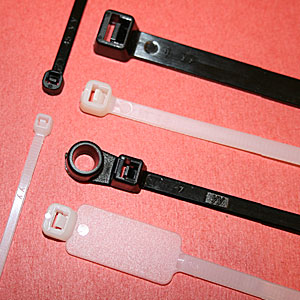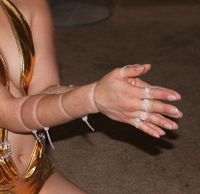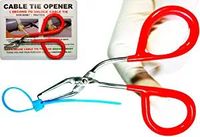Cable tie
A cable tie (also known as a cable binder, zip tie and tie-wrap) is a type of fastener, especially for binding several electronic cables or wires together and to organize cables and wires.
Design and use
In its most popular form, a cable tie consists of a sturdy Nylon tape with an integrated gear rack, and on one end a ratchet within a small open case. Once the pointed tip of the cable tie has been pulled through the case and past the ratchet, it is prevented from being pulled back; the resulting loop may only be pulled tighter. In two of its most common uses, this allows several cables to be bound together into a cable tree, or to be used as makeshift handcuffs as in Panama, the UK and the USA, as well as in other countries like Belgium. Specially constructed physical restraints called PlastiCuffs, based on the cable tie design, are used by police and military to restrain prisoners, especially in the more urban parts of the USA and Panama. Cable ties are also commonly used to prevent hubcaps (also known as wheel trims) from falling off a moving vehicle, and some are sold specifically for this purpose.
A cable tie tensioning device or tool may be used to apply a cable tie with a specific degree of tension. The tool may cut off the extra tail flush with the head in order to avoid a sharp edge which might otherwise cause injury.
Cable ties have a ratcheting system at their head. In order to increase resistance to ultraviolet light in outdoor applications, a specific grade of Nylon containing a minimum of 2% carbon black is used to protect the polymer chains and extend the cable tie's service life. Blue cable ties are supplied to the food industry and contain a metal additive so they can be detected by industrial metal detectors. Cable ties made of ETFE (Tefzel) are used in radiation-rich environments. Red cable ties made of ECTFE (Halar) are used for plenum cabling.
Stainless Steel cable ties are also available for flameproof applications - coated stainless ties are available to prevent galvanic attack from dissimilar metals (e.g. zinc coated cable tie).
History
Cable ties were first invented by Thomas & Betts, an electrical company, in 1958 under the brand name Ty-Rap initially designed for airplane wire harnesses. The original design used a metal ratchet instead of nylon. They later changed to the nylon/plastic design.
Alternatives
Other methods of bundling cable together securely and semi-permanently include cable lacing, binding knots such as the surgeon's knot or constrictor knot, Velcro brand hook-and-loop strips, conveyor belt hooks, twist ties, Rapstrap fasteners, metal buckle clips or Cablox cable management.
Cable ties and BDSM
Cable ties can be used to bind a person or to tie them to an object or piece of furniture.
Care should be exercised when using tie-wraps. Since they are easily tightened and not easily irreversible, you should have a pair of electrical wire cutters or EMT Safety shears readily available.
Tie wraps are available in many colors, and they have a very wide range of styles.
They are readily available at most hardware stores.
An alternative to tie wraps are PlastiCuffs.
Reuse
Cable ties are generally viewed as single-use devices. However, if a closed loop needs to be opened again, then, rather than destroying the cable tie by cutting, it may be possible to release the ratchet from the rack to reuse the cable tie. While some cable ties are designed for reuse with a tab that releases the ratchet, in most cases a sewing needle or similar object (for example a small screwdriver) will need to be interposed between the ratchet and the rack. Ties reused in this way will be weaker than new ones.
To open without cutting it, the ratchet box can be crushed vertically using pliers.
Amazon.com sells a Zip tie opener (asin B08WPW9TZL)[1] for under $10.00. Device has mixed reviews, but works for me R/
References
Chat rooms • What links here • Copyright info • Contact information • Category:Root
Chat rooms • What links here • Copyright info • Contact information • Category:Root


